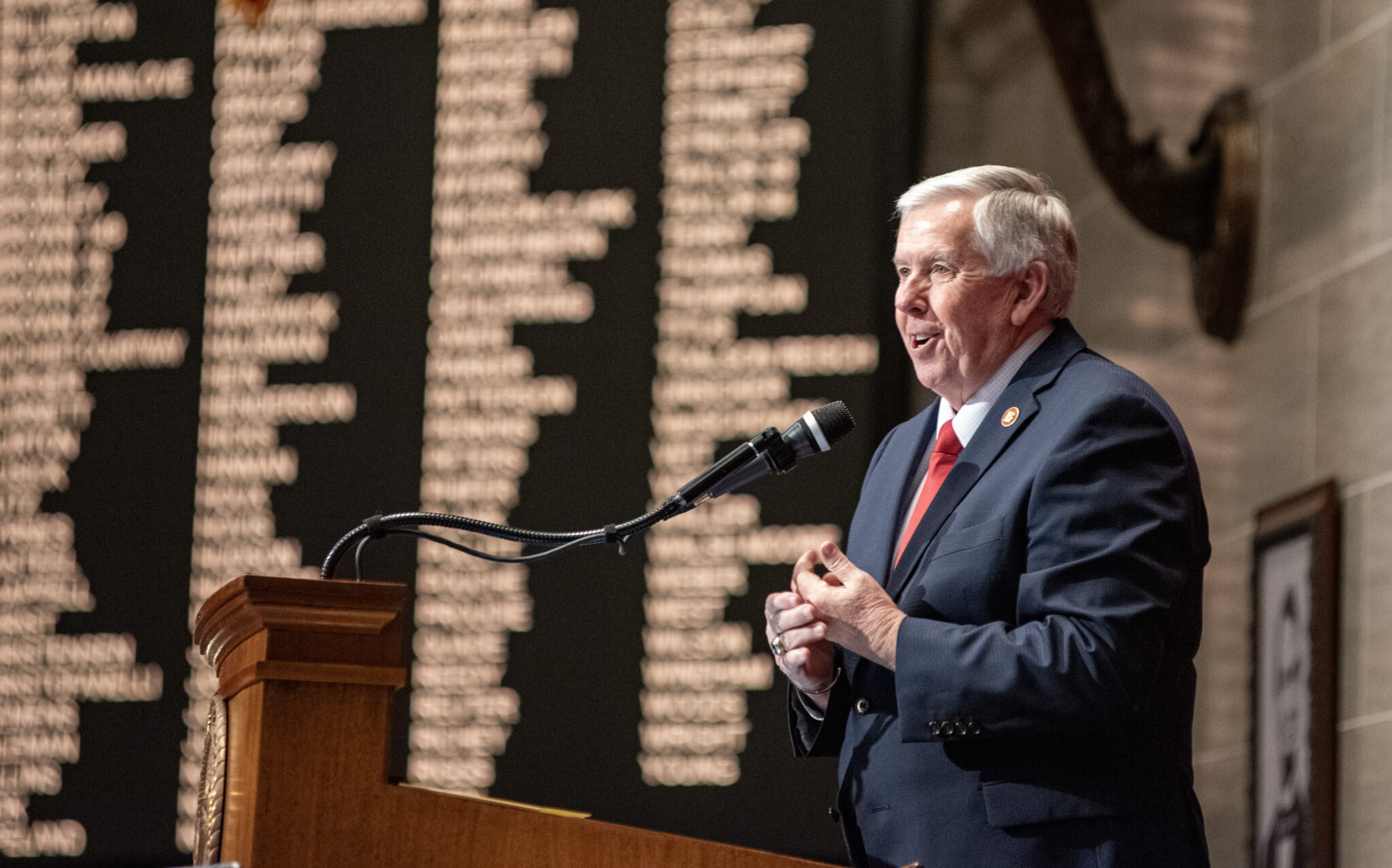Missouri governor slashes $1 billion from state budget approved by lawmakers

More than 170 items were struck from the Missouri state budget Friday as Gov. Mike Parson cut $1 billion from the spending plan passed this year by lawmakers.
In a statement explaining his cuts, Parson said he vetoed earmarked items that he believes were loaded into the budget for special projects and organizations without considering the future financial stability of the state.
“The use of the veto pen is not something I do eagerly, but today these vetoes represent the elimination of unnecessary pet projects and the protection of the taxpayer dime,” Parson said in a news release announcing his budget actions. “We may be leaving $1.9 billion on the bottom line, but that doesn’t mean we spend for the sake of spending.”
It was the second year in a row Parson cut the budget despite near-record surpluses.
One of the biggest cuts was $150 million in general revenue that was part of a $727.5 million plan for expanding Interstate 44 in southwest Missouri. The cut leaves $577.5 million available, with $363 million coming from borrowed money.
Other projects, large and small, that Parson did not approve include grants to not-for-profit organizations, support for local projects and set-asides that targeted a single vendor for a state purchase.
Many of the individual items carried a warning — that the fund being tapped was “grossly overappropriated,” that it was a local responsibility or that the long-term financial health of the state required the cut.
A new education law will cost an estimated $400 million more annually for public schools when fully implemented, with the foundation formula estimated to cost $300 million more in fiscal 2026, Parson wrote in a message repeated several times.
“We have obligations both this year and in future years that must be accounted for today to avoid future budgetary pains tomorrow,” Parson said in the news release.
The budget — $50.5 billion for state operations in the year that begins Monday — has several spending initiatives that Parson did approve. He requested several of them and accepted others added by lawmakers.
- Almost $700 million for roads including the $577.5 million for I-44, $150 million to widen U.S. 67 through Butler County and $40 million for construction on U.S. 65 from Buffalo to Warsaw.
- Full funding of the state’s 75% share of school transportation costs for the third year in a row. The transportation support has not been fully funded for almost 30 years until the budget surplus started growing.
- A 3% increase in funding for state colleges and universities, plus $367 million in new funding to complete construction projects begun in 2022 or for new campus construction.
- A 3.2% pay raise for state employees.
- A boost in state grants to support teacher pay to make the minimum salary $40,000. In May, Parson signed a bill mandating the $40,000 minimum salary for all districts.
- $1.5 billion in federal grant awards to expand broadband access in rural areas.
- $56 million for public and charter schools to provide Pre-Kindergarten programs to all students qualifying for free and reduced lunch.
Parson left in place initiatives he called for, such as increased rates for child care providers, even if the budget did not fund them at the levels he requested.
Some of the vetoed items have become targets for criticism, including $12.5 million to purchase land for a state park in McDonald County inserted into the budget by state Rep. Dirk Deaton of Noel.
Parson also vetoed $1 million to assist Deaton’s hometown recover from the closure of a Tyson plant. The state has helped plan job fairs and sought to market the Tyson plant site, the veto message states.
“Beyond all of these efforts, the state has been unable to determine the intended use of these specific funds,” Parson wrote.
There were other items vetoed because there was too little information about how the money would be used.
For one, $502,000 to support an historical society that operates a museum and a cemetery, the administration had no information at all.
“The demographic language is not specific enough to identify where this project is located,” Parson wrote.
Some of the items vetoed were repeats from last year. One of those items was $8 million for a law enforcement training center in O’Fallon in St. Charles County.
“That project is built on a partnership that includes commitments from five different counties from the region,” Parson wrote. “Whereas the state senators that represent the county in which this facility is located voted against (the spending bill), this leads my administration to believe that there is not widespread, regional support for this training facility.”
St. Charles is represented by state Sens. Bill Eigel of Weldon Spring and Nick Schroer of Defiance, members of the Freedom Caucus group that disrupted plans for orderly debate on the budget with a 41-hour filibuster.
One of the smaller earmarked items that was vetoed was $38,000 for sales tax refunds sought by state Sen. Mike Moon of Ash Grove. The refunds were for taxes found to be owed when the interpretation of tax law changed because of a court ruling.
None of the items cut were vetoed because the state lacks money.
On May 31, the general revenue fund held $4.8 billion and there was $1.6 billion in the bank in other funds that could be spent like general revenue. There are also funds set aside for major projects that are not so far along that they couldn’t be stopped, like $600 million set aside for expanding the state Capitol Building.
Parson’s administration put out a two-page summary seeking to dispel the idea that the state has substantial surplus cash. There are large fund balances, the document states, but there are also large pending obligations that will draw down those balances.
”Reductions in revenue and increased ongoing expenditures approved by recent legislation mean we have obligations beyond the current fiscal year that rely on Missouri’s fund balance in the future,” the summary states.
Parson’s budget office projects a $1.9 billion general revenue balance on June 30, 2025. The budget passed by lawmakers spent $50.9 billion total on state operations, with $15.2 million from general revenue.
Parson said in the news release that he cut that to $50.5 billion total for operations and $14.9 billion in general revenue. The budget is based on a projection for $13.1 billion in general revenue receipts.
That means an accumulated surplus must be tapped to fill the gaps on ongoing operations, but there are trends that will reduce the drawdown.
Last June 30, Missouri had a general revenue surplus of $5.1 billion, $1.3 billion more than had been projected when the budget for that fiscal year was written.
Parson’s budget proposal from January projected it would decline to $3.2 billion when the current year ends Sunday and stand at $1.6 billion on June 30, 2025.
Those estimates were based on a slight decline in revenues this year, but through Thursday collections are up 1.1%, which will add a small amount to the surplus. The state has collected $94 million more in general revenue in the current year, $13.3 billion total so far, than in fiscal 2023.
The estimate for almost flat revenue in the coming year is unchanged, Budget Director Dan Haug said Friday in an email to The Independent.
That would mean approximately $200 million would be available during the coming fiscal year that is not anticipated in the original budget.
The other factor reducing the draw on general revenue and other state funds is understaffing at state agencies, in some cases more than 10% down from authorized strength.
Working to reduce state revenue are pending tax cuts. If this fiscal year ends with revenue exceeding last year’s total by $200 million, it would trigger a reduction in the top income tax rate of 0.1%, to 4.7%, on Jan. 1.
The increase through Thursday isn’t enough to trigger the refund but there are collections to come.
“We won’t,” Haug said, “be able to make that calculation until after we see what final collections will be.”
Miss Clipping Out Stories to Save for Later?
Click the Purchase Story button below to order a print of this story. We will print it for you on matte photo paper to keep forever.

